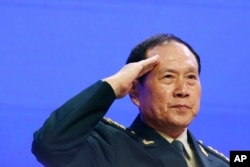Asian countries that pride themselves on neutral foreign policies face growing pressure to support either China or the United States in a sticky maritime sovereignty dispute, but they are expected to bid for both and keep the aid coming in.
Southeast Asian claimants to the disputed South China Sea grappled with the prospect of choosing sides over the weekend at the annual Shangri-la Dialogue defense forum in Singapore. The question loomed so large that Singapore Prime Minister Lee Hsien Loong warned of smaller countries being “forced” to take sides.
“This is probably going to lead to a situation that the Singapore prime minister called being forced to choose between two sides,” said Jay Batoncbacal, international maritime affairs professor at University of the Philippines. "So, that’s really the problem here if it continues to escalate.”
As the two superpowers disagree over control of the sea and each seeks external support, Asian countries may find it increasingly hard to count both as friends. To take the U.S. side risks economic punishment by China, while the United States might forego military support to an overt China backer.
China’s appeal
China wants other countries to accept economic boosts and bilateral talks to settle maritime sovereignty issues. Beijing has already pushed for joint undersea fuel exploration with Vietnam and the Philippines, two frontline South China Sea states. It has funded infrastructure in a third, Malaysia.
At the Shangri-la Dialogue, attended by more than 600 delegates from 40 countries, Chinese Defense Minister Wei Fenghe appealed for “mutual cooperation” and hoped that no one would “underestimate the wisdom and ability of regional countries to properly handle differences and maintain peace.”
Without naming the United States, Wei urged other countries to snub anyone who goes against those goals. The U.S. government does not claim the sea, but it has passed naval ships through it 11 times since 2017 and flown B-52 bombers over the waterway to check China.
China had alarmed much of Asia, particularly in Southeast Asia, by landfilling tiny islets in the sea for military use.
“In terms of the big picture, Wei Fenghe, last year he represented (Chinese President) Xi Jinping with a statement saying he wants to repair relations with neighbors,” said Huang Chung-ting, Chinese politics and military affairs assistant research fellow with the Institute for National Defense and Security Research in Taipei. “He hoped there wouldn’t be too many issues of excessive conflict.”
Countries that offend China at sea risk being expelled by Chinese coast guard ships or running up against its annual mid-year fishing bans, Huang said. China also has a record of boycotts and withdrawal economic support for countries – South Korea, for example -- that go against its views.
US to strengthen “network”
The United States extends joint military exercises and occasional arms sales in Southeast Asia to help the South China Sea remain open internationally despite 10 years of increasing control by China. China claims 90 percent of the sea, more than the Southeast Asian states, all of which are militarily weaker.
The United States is “strengthening” an “unrivaled network of alliances and partnerships” that includes joint naval exercises, U.S. acting defense Secretary Patrick Shanahan told the defense dialogue. He urged an “end” to Chinese “behavior.”
In May, the United States drilled alongside a French aircraft carrier, a Japanese helicopter carrier and two Australian vessels in the Indian Ocean. All participants have previously sent vessels to the South China Sea.
“No other nation can match the United States’ ability to work across distance, cultures, languages, and time – and we are increasing the rate at which we do this,” he said.
Complex foreign policies
Brunei, Malaysia, Taiwan, Vietnam and the Philippines all vie with China’s claims to the 3.5 million-square-kilometer South China Sea. They prize its fisheries and fossil fuel reserves.
Those countries plus Indonesia, which occasionally chafes with China at the sea’s southern reach, normally pursue foreign policies that sustain Chinese economic aid, such as development loans, as well as military ties with Washington. Non-claimant states such as India and Japan side more geopolitically with the United States without closing economic doors with China.
The Philippines, for example, let its navy train with the United States in April as it accepts billions of dollars in Chinese development aid.
Countries are unlikely to take sides overtly but could face pressure from China during national elections, said Jonathan Spangler, director of the South China Sea Think Tank in Taipei. Some have lost faith in China to be “responsible” and, since 2017, pared back “trust” in the United States.
“I think that countries at least in public should be calling for peaceful resolutions,” Spangler said. Before elections, he added, “We don’t even know the extent to which that sort of covert influence in other countries’ domestic politics has gone on.”










